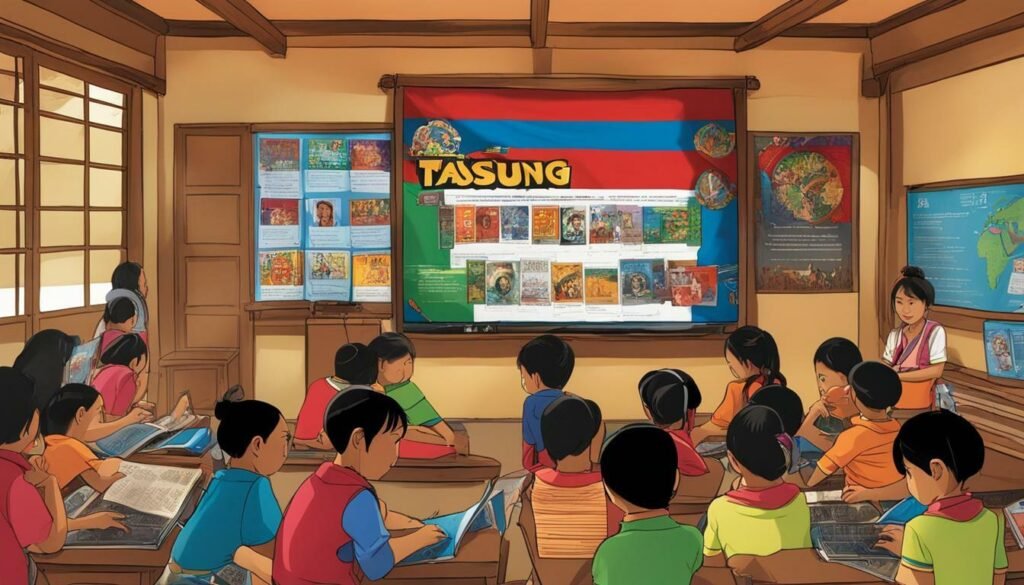The Tausug Language holds a rich history and plays a significant cultural role in the Philippines. It is an Austronesian language spoken in the province of Sulu in the Philippines, as well as in parts of Malaysia and Indonesia. Tausug is closely related to the Butuanon language of northeastern Mindanao and shares lexical similarities with other Philippine languages, Malay, and Arabic. The language is primarily written using the Latin alphabet, although historically it was written using the Arabic alphabet.
- Tausug Language is an Austronesian language spoken in the Philippines, Malaysia, and Indonesia.
- It is closely related to the Butuanon language of northeastern Mindanao.
- Tausug has lexical similarities with other Philippine languages, Malay, and Arabic.
- The language is primarily written using the Latin alphabet.
- Tausug is spoken by approximately 1 million people in various regions including the Sulu Archipelago, Zamboanga Peninsula, Southern Palawan, Sabah, and Kalimantan.
Austronesian Language with Diverse Roots
The Tausug Language belongs to the Austronesian language family and shares lexical similarities with other Philippine languages, as well as Malay and Arabic. It is an indigenous language spoken by approximately 1 million people in the Sulu Archipelago, Zamboanga Peninsula, Southern Palawan, Sabah, and Kalimantan. Its significance extends beyond the borders of the Philippines, as it is also spoken in parts of Malaysia and Indonesia.
“The Tausug Language is a testament to the rich cultural diversity of the region, with its diverse linguistic roots and influences.”
Like other Austronesian languages, Tausug has its origins in the migration of Austronesian-speaking peoples across Southeast Asia and the Pacific. It is closely related to the Butuanon language of northeastern Mindanao, further highlighting the linguistic connections within the region. Tausug has also absorbed vocabulary from neighboring languages, including Malay and Arabic, which have shaped its unique linguistic characteristics.

One of the remarkable aspects of the Tausug Language is its historical writing systems. While the language is primarily written using the Latin alphabet today, it has undergone a transition from the Arabic alphabet in the past. This transition represents the cultural assimilation and evolving writing practices of the Tausug people over time, reflecting the interaction between different civilizations and influences.
The diversity and complexity of the Tausug Language not only showcase the linguistic richness of the Philippines but also underscore the cultural significance and heritage it embodies. Through language preservation efforts and the integration of Tausug in education and media, the language continues to thrive and contribute to the preservation of cultural identity and traditions.
Overall, the Austronesian roots of the Tausug Language illuminate the interconnectedness of languages within the region, while its unique features and historical writing systems highlight the cultural significance and resilience of the Tausug people. By recognizing and preserving the Tausug Language, we honor the diverse linguistic tapestry of the Philippines, Malaysia, and Indonesia.
Geographic Distribution of Tausug Language
The Tausug Language is primarily spoken by approximately 1 million people in the Sulu Archipelago, Zamboanga Peninsula, Southern Palawan, Sabah, and Kalimantan. These regions, scattered across the Philippines, Malaysia, and Indonesia, serve as the cultural and linguistic heartland of the Tausug people. The language holds a significant position in these areas, shaping the identity and heritage of its speakers.
The Sulu Archipelago, located in the southwestern Philippines, is home to a large Tausug-speaking population. This group of islands, comprised of Jolo, Tawi-Tawi, and other smaller isles, serves as the center of Tausug culture and tradition. In the Zamboanga Peninsula of the Philippines, Tausug is also spoken by a notable community.
Outside of the Philippines, the Tausug Language is spoken in Southern Palawan in the Philippines, as well as in the neighboring regions of Sabah in Malaysia and Kalimantan in Indonesia. The Tausug people have long-established connections and migrations across these areas, resulting in the spread of their language and culture.
Throughout these regions, the Tausug Language continues to thrive as a vital means of communication and cultural expression. Its geographic distribution reflects the widespread presence and influence of the Tausug people, bridging communities and fostering a sense of shared heritage.
| Region | Estimated Tausug Population |
|---|---|
| Sulu Archipelago (Philippines) | 600,000 |
| Zamboanga Peninsula (Philippines) | 150,000 |
| Southern Palawan (Philippines) | 100,000 |
| Sabah (Malaysia) | 100,000 |
| Kalimantan (Indonesia) | 50,000 |
Historical Writing Systems of Tausug Language
The Tausug Language has historically been written using the Arabic alphabet, but in modern times, it is primarily written using the Latin alphabet. The use of the Arabic alphabet for writing Tausug can be traced back to the influence of Islam in the region. Arabic script was introduced by Muslim scholars and traders, and it became the dominant writing system among the Tausug people. However, with the arrival of Spanish colonizers in the Philippines, the Latin alphabet began to gain prominence in the region. Over time, the Tausug Language adapted to this new writing system, incorporating Latin characters and diacritics to represent its unique phonetic sounds.
Despite the shift to the Latin alphabet, the Tausug Language still retains elements of its Arabic roots in its orthography. Certain sounds, such as the “ayn” and “qaf” sounds, which are not present in the Latin alphabet, are represented by modified letters or diacritics. This blending of Arabic and Latin scripts allows for a more accurate representation of the Tausug language’s phonetics.
In addition to the Arabic and Latin alphabets, there have been other writing systems used for the Tausug Language throughout history. These include indigenous scripts and adaptations of the Jawi script, a modified Arabic script used in Southeast Asia. These alternate writing systems, while not as widely used as the Arabic and Latin alphabets, provide valuable insights into the evolution of the Tausug Language and its connections to the broader linguistic traditions of the region.

In summary, the Tausug Language has a rich history of using various writing systems. From its origins in the Arabic alphabet to its adaptation of the Latin alphabet, the Tausug Language has evolved alongside the cultural and historical influences in the region. The choice to primarily use the Latin alphabet in modern times reflects the changing linguistic landscape and the importance of accessibility and standardization. However, the inclusion of Arabic script elements and other writing systems highlights the unique linguistic heritage of the Tausug people and their language.
Unique Features of Tausug Language
The Tausug Language possesses distinct features in terms of grammar and vocabulary, setting it apart from other languages in the region. These unique characteristics contribute to the richness and cultural significance of the language, reflecting the history and diversity of the Tausug people.
One notable feature of the Tausug Language is its complex system of verb conjugation. Verbs in Tausug undergo various affixation processes to indicate tense, aspect, mood, and voice. This allows for precise and nuanced expression of actions and events. For example, the verb “to eat” can be conjugated differently depending on whether the action is ongoing, completed, or intended for the future.
Another distinctive aspect of the Tausug Language is its extensive vocabulary related to maritime and seafaring activities. This reflects the historical livelihood of the Tausug people, who have long been engaged in fishing, trading, and navigation. Words for different types of boats, fishing techniques, and seabed features are abundant in the Tausug lexicon, showcasing their deep connection to the ocean.
Table: Examples of Tausug Vocabulary
| Tausug Word | English Translation |
|---|---|
| durugan | canoe |
| pukat | fishnet |
| panarawb | seashell |
| tartan | anchor |
| lawak | coral reef |
Additionally, the Tausug Language incorporates loanwords from various sources, reflecting the cultural influences and historical exchanges experienced by the Tausug people. Malay and Arabic loanwords are particularly prominent, enriching the vocabulary of the language and highlighting the connections between different cultures in the region.

“The Tausug Language possesses distinct features that reflect the richness of Tausug culture and history. Its unique grammar and vocabulary showcase the significance of language in preserving the identity and heritage of the Tausug people.”
The Tausug Language serves as a testament to the cultural diversity of the Philippines and the resilience of its linguistic heritage. As efforts continue to preserve and promote the Tausug Language, it remains an integral part of Tausug identity and a symbol of their rich traditions.
Cultural Significance of Tausug Language
The Tausug Language holds immense cultural significance, playing a vital role in preserving traditions and a sense of heritage. As an Austronesian language spoken in the Philippines, Tausug serves as a means of communication for approximately 1 million people in the Sulu Archipelago, Zamboanga Peninsula, Southern Palawan, Sabah, and Kalimantan.
Tausug language is deeply intertwined with the cultural fabric of the Tausug people. It serves as a vehicle for passing down centuries-old traditions, oral histories, and the values that define their unique identity. Through the language, the Tausug community is able to maintain a strong connection to their ancestors and their rich heritage.
Traditions such as pangalay, a traditional dance, and yakan weaving, a traditional art form, are intricately linked to the Tausug Language. The language provides the necessary vocabulary and nuances to understand and appreciate these cultural practices fully. It allows for the transmission of knowledge from one generation to the next, ensuring that these traditions are not lost in the passage of time.
In a world that is becoming increasingly globalized, the preservation of the Tausug Language is crucial. It helps to safeguard the unique identity of the Tausug people and offers a source of pride and belonging. Through the continued use and promotion of the Tausug Language, future generations can continue to celebrate and carry forward their cultural heritage.

| Tausug Language | Cultural Significance |
|---|---|
| Preserves traditions | Ensures that centuries-old customs and practices are passed down and celebrated. |
| Maintains a sense of heritage | Connects the Tausug community to their ancestors and roots, fostering a strong cultural identity. |
| Enables understanding of cultural practices | Provides the necessary vocabulary and nuances to fully appreciate traditional art forms and customs. |
| Promotes pride and belonging | Offers a source of pride and belonging to the Tausug people, strengthening their sense of self. |
Importance of Tausug Language Preservation
The preservation of the Tausug Language is crucial for safeguarding the cultural heritage it represents. As an Austronesian language spoken in the Sulu Archipelago, Zamboanga Peninsula, Southern Palawan, Sabah, and Kalimantan, the Tausug Language holds immense historical and linguistic significance.
With approximately 1 million speakers, the Tausug Language serves as a connecting thread to the rich cultural traditions and customs of the Tausug people. It is through language that stories, myths, and traditional practices are passed down from one generation to another, forming a vital part of their identity.
Language preservation is essential in ensuring the continuous transmission of cultural knowledge. By preserving the Tausug Language, we preserve the unique worldview embedded within its grammar, vocabulary, and expressions. This linguistic heritage not only strengthens the cultural fabric of the Tausug community but also enriches the broader understanding and appreciation of the diverse linguistic tapestry of the Philippines.
| Benefits of Tausug Language Preservation |
|---|
| 1. Cultural Identity: |
| – Preserving the Tausug Language helps maintain the distinct cultural identity of the Tausug people, reinforcing their sense of belonging and pride. |
| 2. Intergenerational Bonding: |
| – Language preservation fosters stronger connections between generations, facilitating the transfer of cultural values and knowledge from elders to the younger members of the community. |
| 3. Linguistic Diversity: |
| – By protecting the Tausug Language, we contribute to the preservation of linguistic diversity, highlighting the value of language as a fundamental human right. |
“Language is the road map of a culture. It tells you where its people come from and where they are going.” – Rita Mae Brown
The Time is Now
Language revitalization efforts are integral to ensuring the longevity of the Tausug Language. Through initiatives such as community language programs, educational curriculum integration, and increased media representation, the Tausug Language can flourish and thrive in the modern world.
The preservation of the Tausug Language goes beyond mere linguistic considerations; it is a testament to the resilience and spirit of the Tausug people. By valuing and supporting language preservation efforts, we contribute to the preservation of cultural heritage and the celebration of linguistic diversity.

The Tausug Language is making strides in education and media platforms, contributing to its revitalization. Recognizing the importance of preserving this unique language, educational institutions are incorporating Tausug language programs into their curriculum. These programs aim to teach students not only the language itself but also the cultural and historical significance that accompanies it. By providing opportunities for Tausug children and young adults to learn their native language, these initiatives play a crucial role in maintaining the language’s vitality.
Media platforms have also embraced the Tausug Language, promoting its use through various channels. Television and radio broadcasts now feature Tausug-language shows and programs, allowing the language to reach a wider audience. This increased visibility helps foster a sense of pride among Tausug speakers and encourages linguistic preservation. Furthermore, online platforms provide a space for Tausug language enthusiasts to connect, share resources, and actively contribute to the language’s growth.

Language revitalization through technology
Technology plays a significant role in the revitalization of the Tausug Language. Language-learning apps and online resources offer accessible tools for individuals interested in learning or improving their proficiency in Tausug. These digital platforms provide interactive lessons, vocabulary exercises, and audio recordings, enhancing language-learning experiences.
The power of media representation
“Language is not just a means of communication; it is a reflection of our identities and cultures. When we see our language represented in media, it validates our existence and strengthens our connection to our heritage.” – Tausug Language Advocate
Through media representation, the Tausug Language gains visibility and contributes to the preservation of Tausug culture. TV shows, films, and music in the Tausug Language showcase the richness and diversity of this linguistic tradition, celebrating its unique expressions and local narratives. By highlighting Tausug voices and stories, media platforms help foster a sense of belonging and pride among Tausug speakers, ensuring that the language continues to thrive for generations to come.
| Education | Media |
|---|---|
| Integration of Tausug language programs in schools | Tausug-language shows on television and radio |
| Cultural and historical significance included in curriculum | Increased visibility and pride for Tausug speakers |
| Opportunities for Tausug children and young adults to learn their native language | Online platforms for linguistic resources and community-building |
Tausug Language in the Modern World
The Tausug Language faces various challenges and opportunities in the modern world, influenced by factors like globalization and changing language dynamics. As technology advances and communication becomes more interconnected, the usage and preservation of minority languages like Tausug have become crucial for maintaining cultural diversity and heritage.
In an era of increasing globalization, the Tausug Language has seen a decline in usage, particularly among the younger generation. English and Filipino, the national language of the Philippines, have become more dominant in education and media, leading to a gradual shift away from native languages. However, efforts are being made to revitalize the Tausug Language and promote its importance in education and cultural preservation.
Language revitalization programs, community initiatives, and the integration of Tausug Language in schools are playing a significant role in ensuring the language’s survival. These efforts aim to empower Tausug speakers, preserve traditional knowledge, and foster a sense of pride in cultural heritage. By providing opportunities to learn, write, and speak Tausug, the language can continue to thrive, adapt, and evolve in the modern world.
| Challenges | Opportunities |
|---|---|
| Globalization and the dominance of English and Filipino | Language revitalization programs and community initiatives |
| Decreasing usage among younger generations | Integration of Tausug Language in schools |
| Loss of traditional knowledge and cultural heritage | Preservation of Tausug language and cultural practices |
Despite the challenges, the Tausug Language has the potential to thrive in the modern world. By embracing new technologies, utilizing social media platforms, and creating online resources, Tausug speakers can connect, share, and celebrate their language and culture globally. The preservation and usage of the Tausug Language are not only crucial for the Tausug community but also contribute to the richness and diversity of the global linguistic landscape.

- Tausug 101: An online platform providing Tausug language learning resources.
- Ethnologue: Information about the Tausug Language and its linguistic classification.
- “The Transition from Jawi to Roman Alphabet in Tausug (Tausug to Tausug)”: An academic paper exploring the historical shift in writing systems for the Tausug Language.
Conclusion
In conclusion, the Tausug Language stands as a vibrant dialect with immense cultural significance, highlighting the need for its preservation and continued promotion.
Tausug is an Austronesian language spoken in the province of Sulu in the Philippines and in parts of Malaysia and Indonesia. It is closely related to the Butuanon language of northeastern Mindanao. With lexical similarities to other Philippine languages, as well as Malay and Arabic, Tausug serves as a linguistic bridge connecting different cultures and histories.
The language is primarily written using the Latin alphabet, but historically, it was written using the Arabic alphabet. This transition in writing systems reflects the dynamic nature of Tausug and its adaptation to changing times.
Spoken by approximately 1 million people across the Sulu Archipelago, Zamboanga Peninsula, Southern Palawan, Sabah, and Kalimantan, Tausug plays a crucial role in preserving traditions and cultural heritage. It is a testament to the rich diversity of languages and cultures in the region.
As the world becomes increasingly globalized, it is essential to recognize the importance of language preservation. The Tausug Language not only represents the identity of its speakers but also contributes to the overall linguistic diversity of the world. By nurturing and promoting the Tausug Language in education, media, and everyday usage, we can ensure its continued vitality and relevance in the modern world.
FAQ
Q: What is the Tausug language?
A: The Tausug language is an Austronesian language spoken in the province of Sulu in the Philippines, as well as in parts of Malaysia and Indonesia.
Q: How is Tausug related to other languages?
A: Tausug is closely related to the Butuanon language of northeastern Mindanao and shares some lexical similarities with other Philippine languages, as well as Malay and Arabic.
Q: What writing systems are used for Tausug?
A: Tausug is primarily written using the Latin alphabet, but historically, it was written using the Arabic alphabet.
Q: Where is Tausug primarily spoken?
A: Tausug is spoken by approximately 1 million people in the Sulu Archipelago, Zamboanga Peninsula, Southern Palawan, Sabah, and Kalimantan.
Q: What are the unique features of the Tausug language?
A: The Tausug language has its own unique grammar and vocabulary.
Q: What is the cultural significance of the Tausug language?
A: The Tausug language plays an important role in preserving traditions and cultural heritage.
Q: Why is it important to preserve the Tausug language?
A: Preserving the Tausug language is crucial for safeguarding cultural heritage and identity.
Q: How is the Tausug language used in education and media?
A: Efforts have been made to incorporate the Tausug language in education and media as part of language revitalization initiatives.
Q: What challenges does the Tausug language face in the modern world?
A: The Tausug language faces challenges in the context of globalization and changing language usage patterns.


